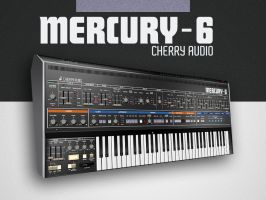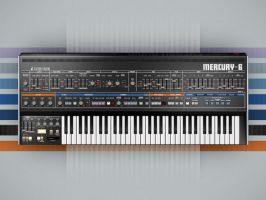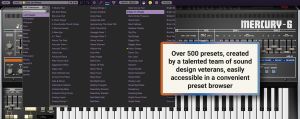
Cherry Audio has released Mercury-6, a virtual synthesizer instrument that emulates and expands on the renowned Jupiter-6, just in time for its 40th anniversary.
Here's what they say:
Mercury-6 captures all that is exceptional in this treasured polyphonic classic, boosts its feature set for today's DAW production and workflow, and celebrates the innovation from the era that changed music forever.
Released in 1983 as an affordable alternative to the Jupiter-8, the Jupiter-6 marked the end of an era in the history of analog polysynths. Though similar in appearance to the Jupiter-8, the Jupiter-6 had a unique sound and features that allowed it to stand apart from its predecessor, partly due to a versatile multimode filter design that lent it a more aggressive sound. The Jupiter-6 had an impressive (at the time) split keyboard functionality and, most notably, was one of the first synthesizers to include the then-new MIDI protocol. It supported multiple simultaneous waveforms, and its earthshaking solo and poly unison modes enabled massive lead and bass sounds. But its six-voice maximum hampered its potential, and its timing was ill-fated with the release of the DX-7 digital synth the same year. Nevertheless, the Jupiter-6 has persevered to become one of the most coveted classic analog polysynths due to its distinctive dark and complex character.
Cherry Audio's Mercury-6 brings the Jupiter-6 experience into the future and celebrates the invaluable contribution that MIDI itself has made to the music community over the past 40 years. Cherry Audio has precisely crafted each facet of the Mercury-6 synthesizer to sound and behave exactly like a vintage hardware Jupiter-6 and then take it further. Mercury-6 accurately reproduces the multimode filter with 24 dB/oct lowpass, 24 dB/oct highpass, or 12 dB/oct bandpass modes. Velocity sensitivity has been added, the split mode improved, and Mercury-6 adds a layer mode capable of stacking two different sounds simultaneously with per-layer stereo panning, detuning, and sustain. A panel control lets users easily exchange settings between the splits and dual layers, or even between presets. And with polyphony extended to 16 notes per layer, it won't so easily run out of voices. Essentially, Mercury-6 is more than two Jupiter-6s and far exceeds the capabilities of even a Jupiter-8.
Cherry Audio has reproduced the Jupiter-6's unique arpeggiator, including the hidden Down/Up mode of the original, and augmented it by adding a Random mode and MIDI tempo sync. A chord memory mode enables multiple notes to be stored and played back with a single key. The searing oscillator cross mod and sync characteristics have been replicated, and the functionality of the original LFOs improved with a retrigger for LFO-1 and an always-on option for LFO-2, expanding the already notable modulation possibilities of the original hardware.
Cherry Audio has also introduced an integrated studio-quality effects panel with distortion, phaser, flanger/chorus, delay, and reverb, with independent settings for each layer. With additional touches such as per-layer drift control, over 500 expertly designed presets, and Cherry Audio's acclaimed MIDI mapping functions, Mercury-6 will satisfy both vintage synth aficionados and today's music producer.
The Mercury-6 synthesizer can be purchased at cherryaudio.com and authorized resellers, such as the KVR Marketplace, for $49 (list $69).
Mercury-6 is available for Windows and macOS, with macOS 13 Ventura and native Apple M1 processor support, including Apple M1 Ultra. Mercury-6 is provided in AU, VST, VST3, AAX, and standalone formats, and a free 30-day demo is available.

Find Mercury-6 Synthesizer in the KVR Marketplace





